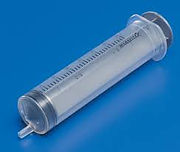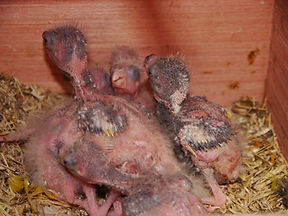
Hand Rearing Kakariki
I first of all need to state that no baby kakariki hand reared or parent reared should be sold on unweaned for a purchaser to continue the hand rearing. Infact no baby below 8 weeks of age should be sold at all. Kakariki wean at around 45 days and will take soft foods only at this point, its not until 55 days that they are considered to eat the same as the parents. Please don't encourage these unscrupulas idiots i won't even call them breeders, as they are scum, by buying under age birds.
I have heard many stories of late of 5-6 week old babies being sold on as weaned and silly tame, kaks are rarely silly tame even hand reared, but at 5-6 weeks, yes they'll sit quite nicely in your hand, therefore the scum bags get away with it. "PLEASE DON'T BE FOOLED" all adverts on sites should be reported to the admins and if necessary the rspca. Please don't be tempted to sell at this age. It's a 5 year ban from keeping animals and a hefty fine as far as i'm aware of, if caught.
When To Start
Baby birds should be left with the parent birds for as long as possible if one wishes to maximise immunity from the parents. Also, intestinal flora is passed from parent to young along with regurgitated, somewhat pre‐digested food, assisting the young birds with digestion. Nesting and feeding behaviour is learned in the nest, so the young who learn from their parents may eventually make better parents themselves.
When removing baby birds from the nest for hand raising, the safety of the young must be the primary consideration. If there is any danger of parental neglect or if aggression exists, the young should be removed.
Most birds can be tamed if removed around the time of natural weaning and hand fed for a few day’s to a couple of weeks.
If incubator hatched young are not placed with foster parents, they will be totally dependent on hand feeding. Because the yolk sac provides initial nourishment, just hatched birds may not need to be fed for the first 12‐14 hours. Many aviculturists and avian veterinarians recommend feeding fluids or very dilute formula at this stage, gradually thickening the consistency of the formula over a 3 or 4 day period.
Housing
The nursery may consist of brooders, pediatric units or similar enclosures that have observation windows and temperature and humidity controls. Proper environmental conditions are essential for normal feeding response and efficient digestion. Young birds should be watched closely for evidence of chilling or overheating. With either extreme in temperature, the birds will grow more slowly and the rate of crop emptying and digestion of food may be delayed or stopped. Birds that are too hot will pant and if feathered may sit with their wings outstretched. Birds that are cold may shiver and huddle together.
The ideal relative humidity is greater than 50%, and the ideal temperature will decrease as the birds begin to feather. In general hatchlings should be kept between 90‐94°F. Birds that are fully feathered can be maintained at room temperature (70‐80°F).
Heating pads and lamps are unreliable and can create an environment that is too hot or too cold. BE CAREFUL! A brooder with temperature and humidity control is ideal. Brooders with straight sides are recommended over those with rounded bottoms, to prevent leg problems.
Bedding material should always be kept clean and dry. Avoid using materials that the bird may ingest. If the birds are observed eating the bedding material, use another type of substrate. We recommend paper towels, tissues or unprinted newspaper (butchers’ paper). This material should be changed at each feed.
Hand Rearing A Kakariki
Kakariki’s are probably one of the easiest birds to hand rear like the adult Kak they love their food. However, to do this you must be committed as it’s like having a new born baby in the house all over again. There are a few things you need to know and implements you need in which to successfully and safely do this. This can be such a rewarding and thrilling time but extremely hard work and utter commitment as this little one now depends on you being Mum & Dad.
What You Need To Know:
First of all Kakariki in general make wonderful parents and unless you are specifically wanting to hand rear you may never have too. Very few problems tend to arise but the one that’s most common is Mum plucking the fur and then the feathers, in which case I recommend to either move the chicks to another sitting hen or hand rear. This problem seems to be caused in the main, by breeding a hen to young and once they start they rarely stop. However just like any animal or their are just bad parents who for no apparent reason kill, injure & Mutilate their young. so she should not be bred from again.
The above picture demonstrates a severe case of Feather plucking by parents
What age is best to take to start hand rearing?
The ideal age assuming it’s not an emergency is 3 weeks old by this time they have received a good supply of nutrients from Mum and are starting to feather up so the use of a brooder is not essential.
What Do I Need?
Once you made that decision to hand rear you then need to know what to do first: Any baby under 3-4 weeks old require heat, to do this you can either buy an expensive incubator or make/buy from the likes of eBay, cheaper homemade ones. You also will need to know the temperature & humidity required for the age of the bird please see guide below for this. Now what should I feed it? For this you will require a bird formula like Kaytee Exact hand feeding formula, each brand will tell you how to mix and each may be different so it is worth reading the label. Also I’m not sure how true it is but I’ve always been told never to mix brands once you started on one don’t swap straight over to another brand as the change can kill, not sure on the truth but not worth finding out. Now it’s how should I feed? for this you need to have either or both syringes and/or a bent up spoon I personally prefer to syringe feed but there is no wrong way which ever suits you or the bird. Some people like to keep a record of their weight to ensure all is going well and their gaining weight each day. Syringes ranging from 20ml down to 5ml are required depending on the age of the chick.




